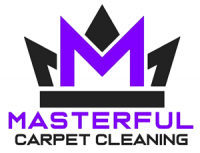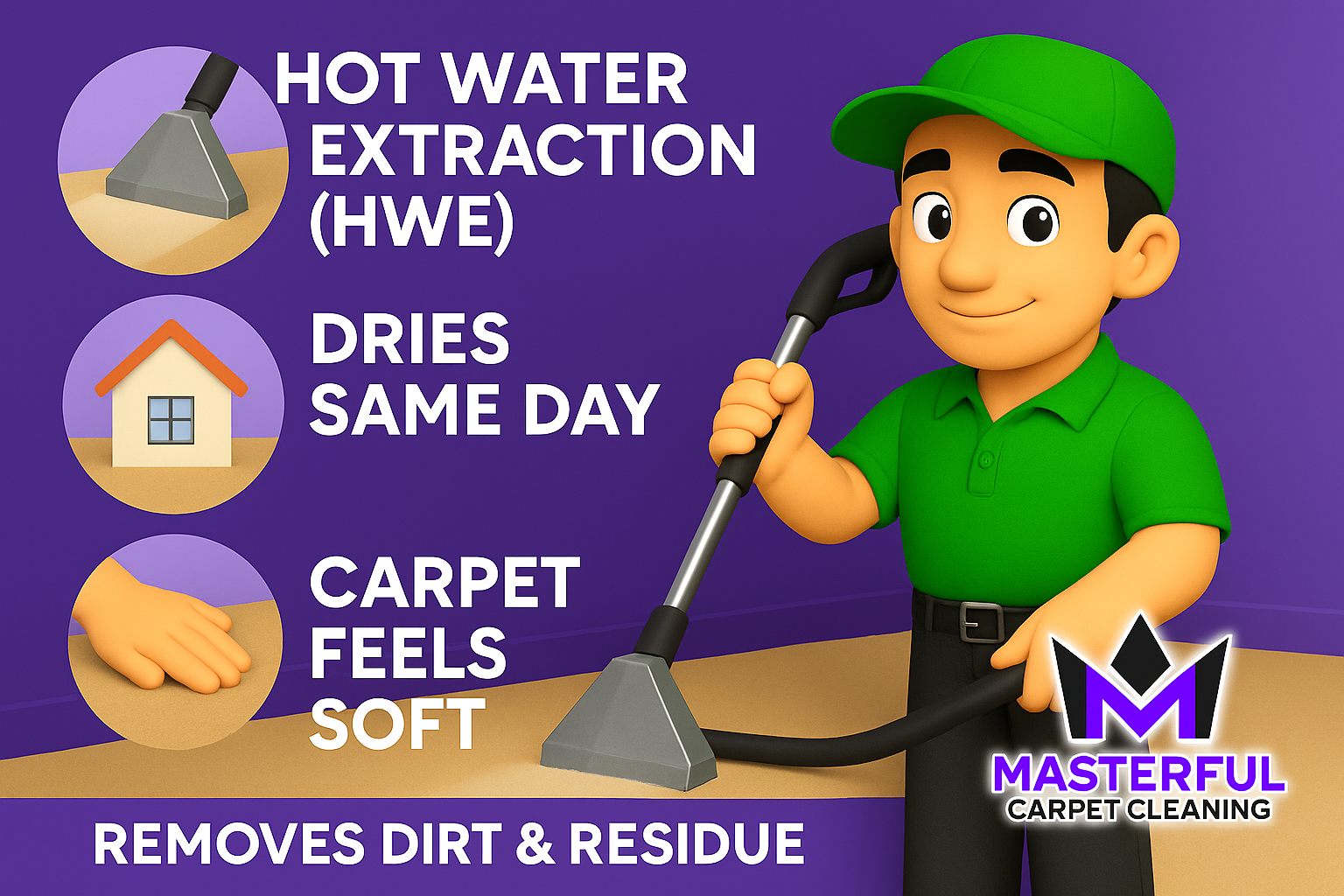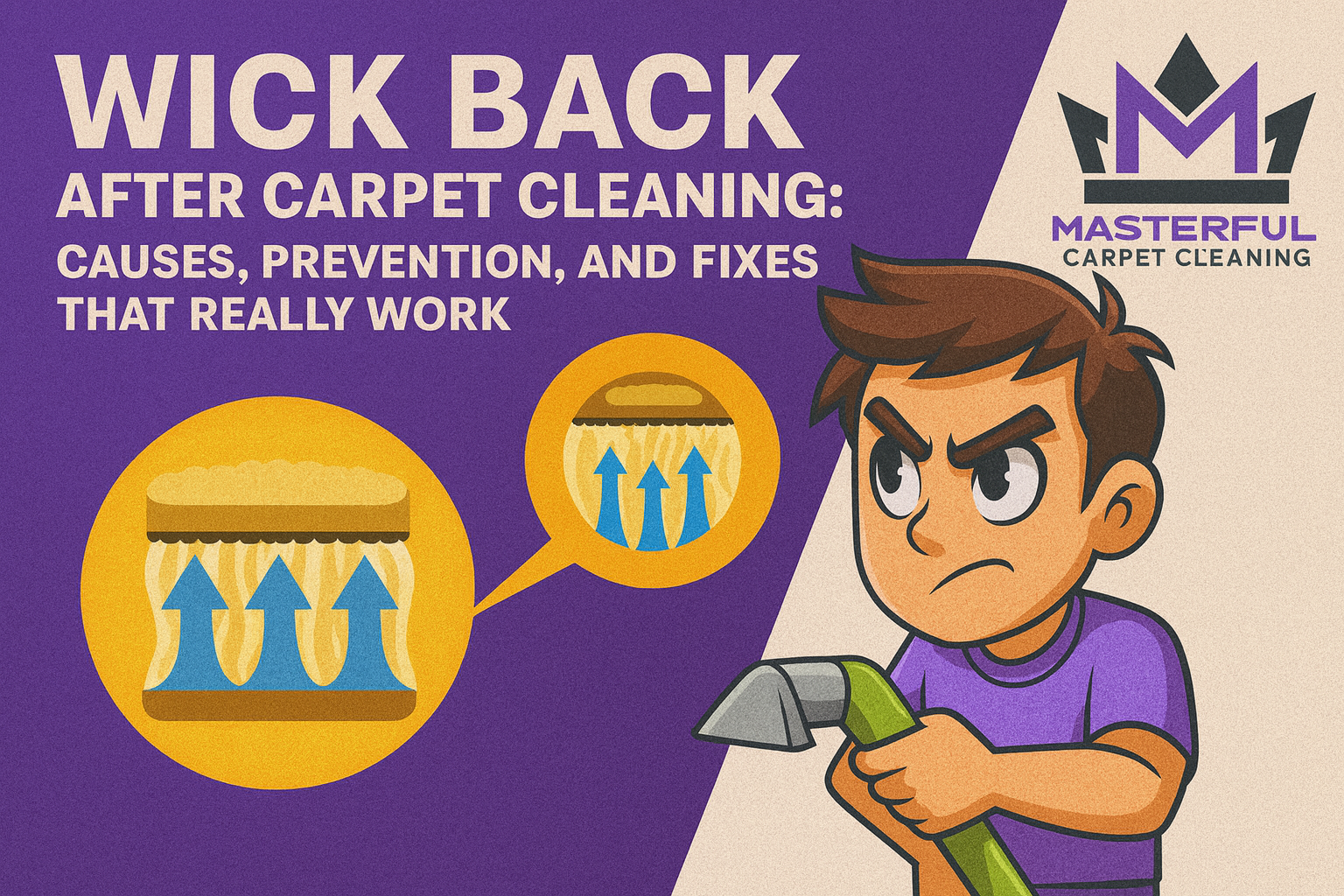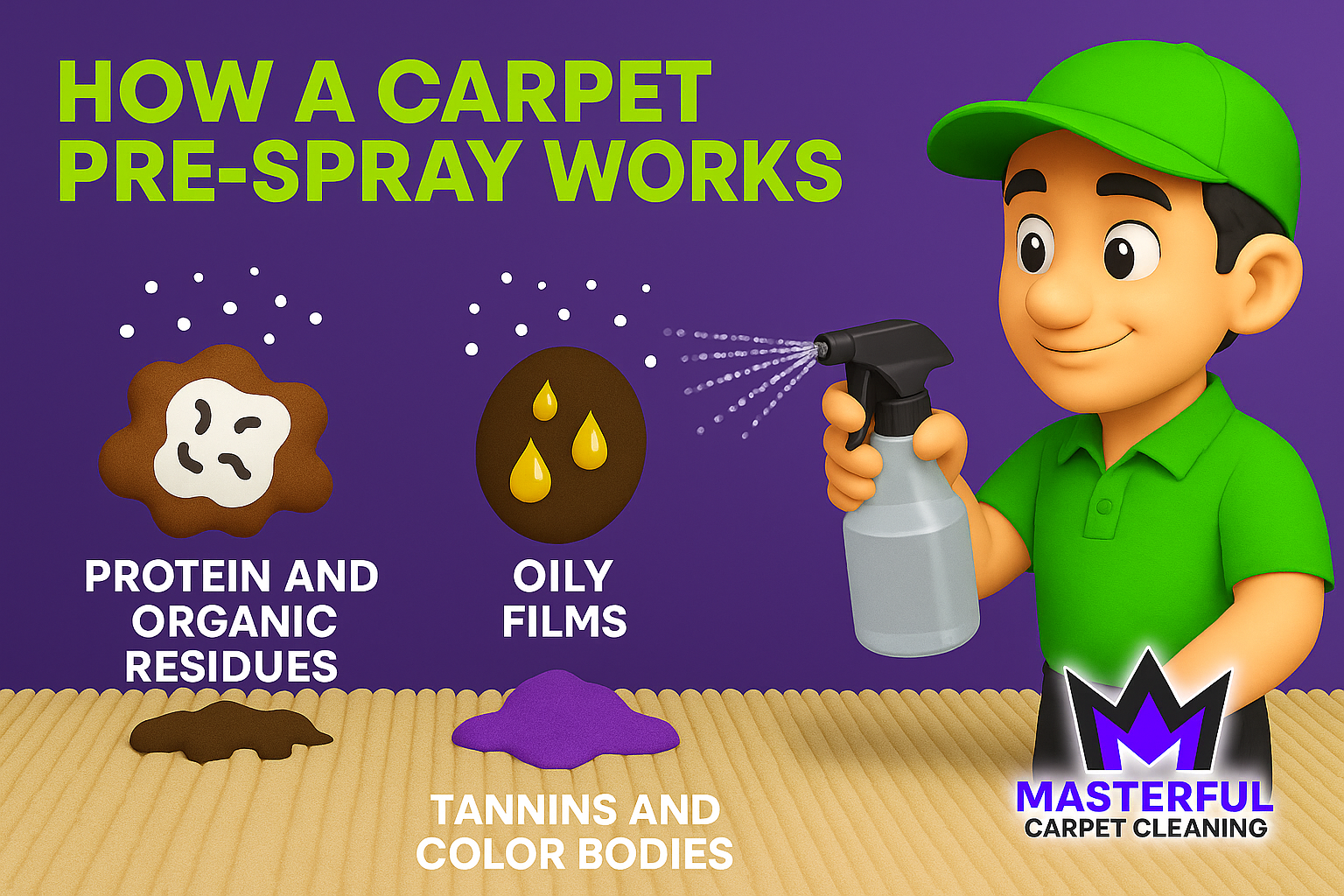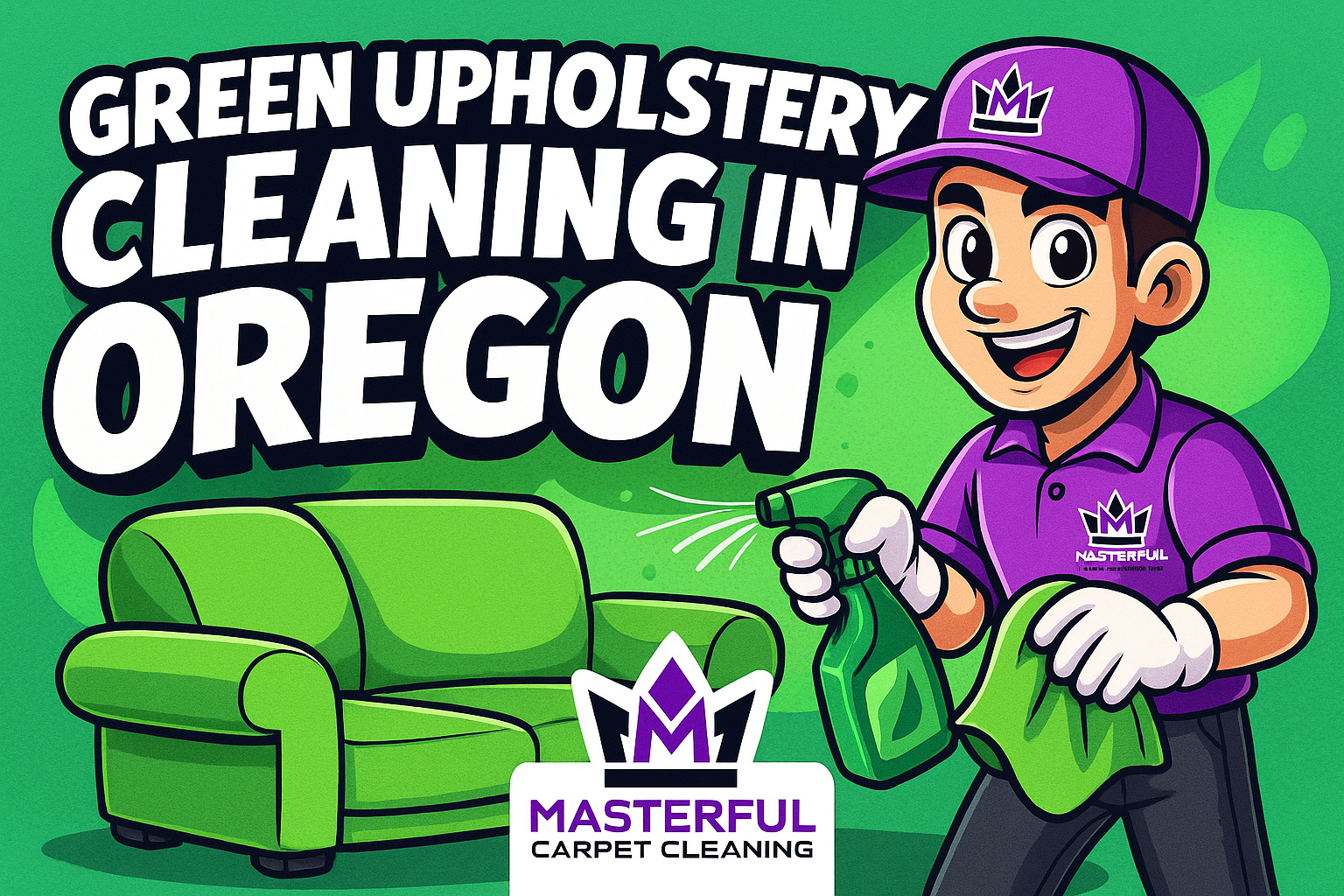Dry Compound Carpet Cleaning: When It Works
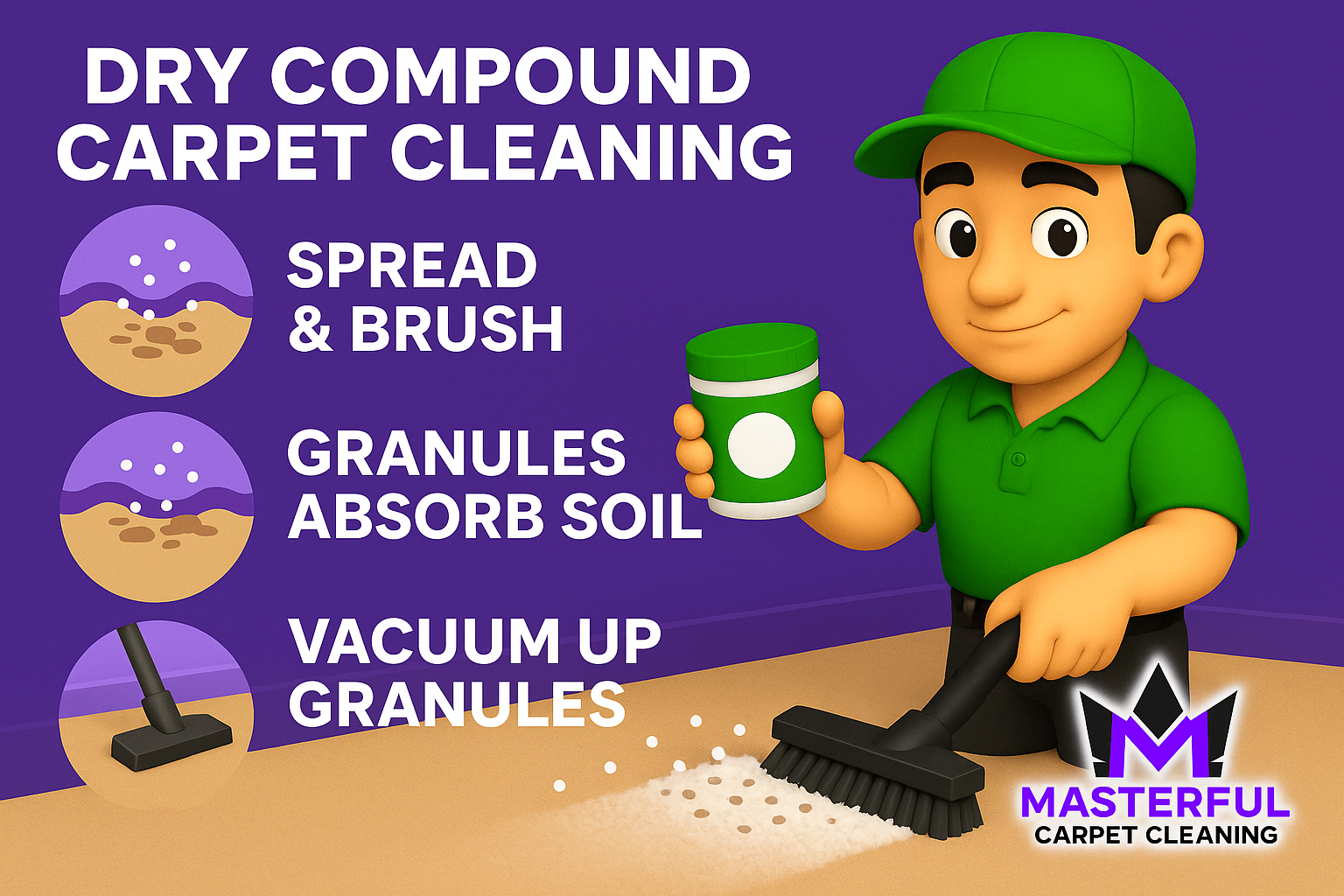
Dry compound carpet cleaning spreads soft, absorbent granules across your carpet, gently brushes them into the fibers, then vacuums them away. The granules act like tiny sponges, grabbing soil so your carpet looks cleaner with almost no added moisture. That means near zero downtime, minimal risk on moistures ensitive rugs and backings, and a tidy process that’s perfect for interim maintenance between deeper cleans.
If you want to see where dry compound sits among all the major methods, this is your one page overview: Ultimate Guide: Carpet Cleaning Methods.
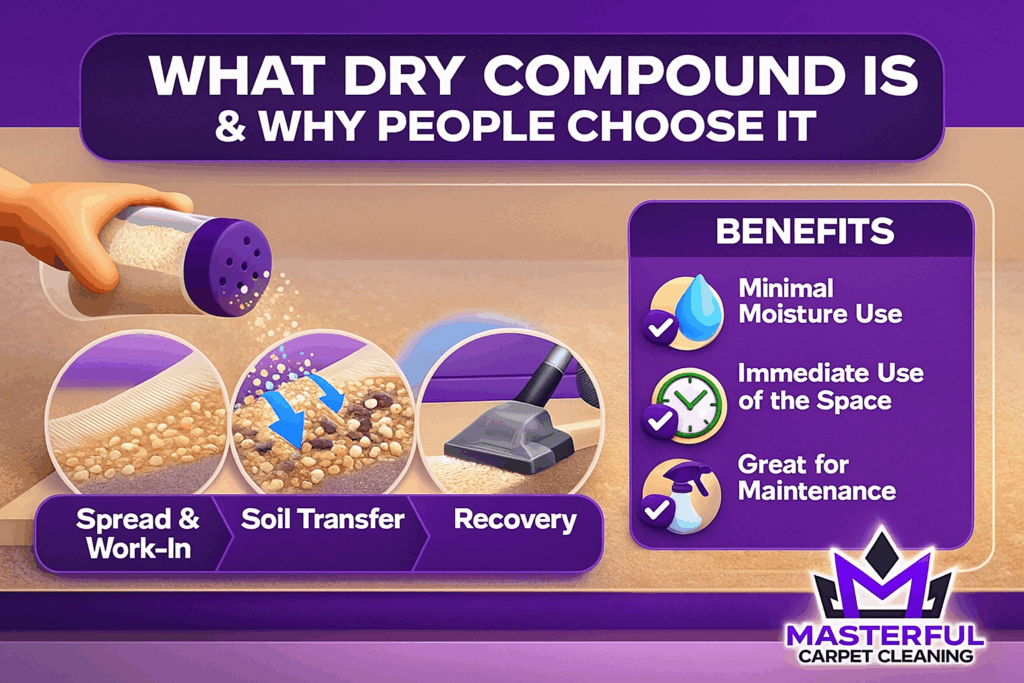
What dry compound is (and why people choose it)
Dry compound (sometimes called absorbent compound or “dry powder”) is made from soft, porous materials designed to be safe to brush through carpet fibers. In use, it’s simple:
- Spread & work in – We apply a measured amount of compound and gently brush it so the particles contact the soiled fiber surface.
- Soil transfer – Light chemistry plus mechanical action encourages soil to move from fiber → compound.
- Recovery – A thorough vacuum removes the soiled granules. Edges, corners, and transitions get detail passes.
- Spot retouches – Stubborn areas receive a focused re-application and re-vacuum.
Bottom line: done properly, dry compound delivers fast, low disruption cleaning with immediate use of the space, no fans, no waiting, no “wet floor” vibe. It’s a highly practical option for busy homes and commercial properties across Salem, Corvallis, Eugene, McMinnville, and Albany.

When dry compound is a smart choice
Dry compound shines in these scenarios:
- Moisture sensitive fibers & backings – Natural plant fibers such as sisal, seagrass, and items with jute backings prefer as little moisture as possible. Dry compound drastically reduces the risk of problems like browning, shrinkage, or dye migration.
- Quick turnarounds in homes, offices, and retail – When you need open floors right now, dry compound’s near zero downtime is hard to beat. For an operational view of low-moisture strategies and budgets, read Low-Moisture Carpet Cleaning: Saving Time & Money.
- Interim maintenance between restorative cleans – You can hold appearance and push out the date of a full “reset.” We often team dry compound with encapsulation on alternating cycles so traffic lanes stay presentable. See how it works here: How Encapsulation Carpet Cleaning Works and the companion guide Encapsulation: Benefits & Techniques.
- Localized issues and edges – Along baseboards, under desks, or in doorways, a granular approach avoids dragging hoses through the entire space. It’s tidy, targeted, and efficient.
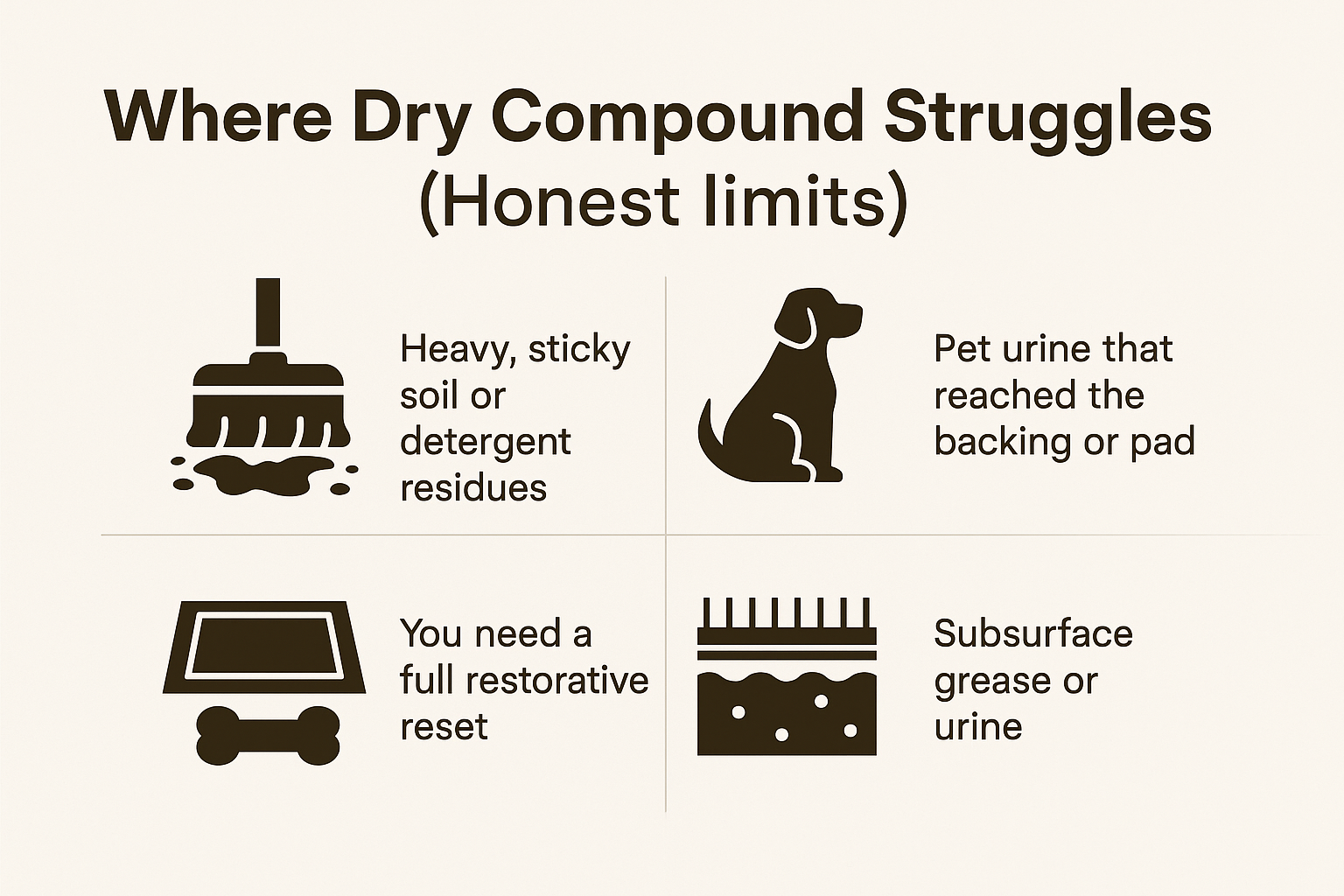
Where dry compound struggles (honest limits)
We love dry compound for what it is, and we’re upfront about where it isn’t the right tool:
- Heavy, sticky soil or detergent residues – If a carpet feels tacky (usually from DIY spotters or old soap), a surface level approach won’t cut it. You need a true rinse to remove the film that traps dirt. This explains why finishing matters: No Residue Carpet Cleaning.
- Pet urine that reached the backing or pad – Dry compound can reduce surface odor, but urine salts often sit below the face yarns. A successful plan typically pairs targeted decontamination with extraction. Here’s what a complete odor strategy looks like: Pet Odor Elimination.
- You need a full restorative reset – When traffic lanes are gray or matted, or residues have built up, we recommend a restorative Hot Water Extraction (HWE) first, then use dry compound or encapsulation for maintenance. Planning a business cadence? Start here: Commercial Carpet Cleaning.
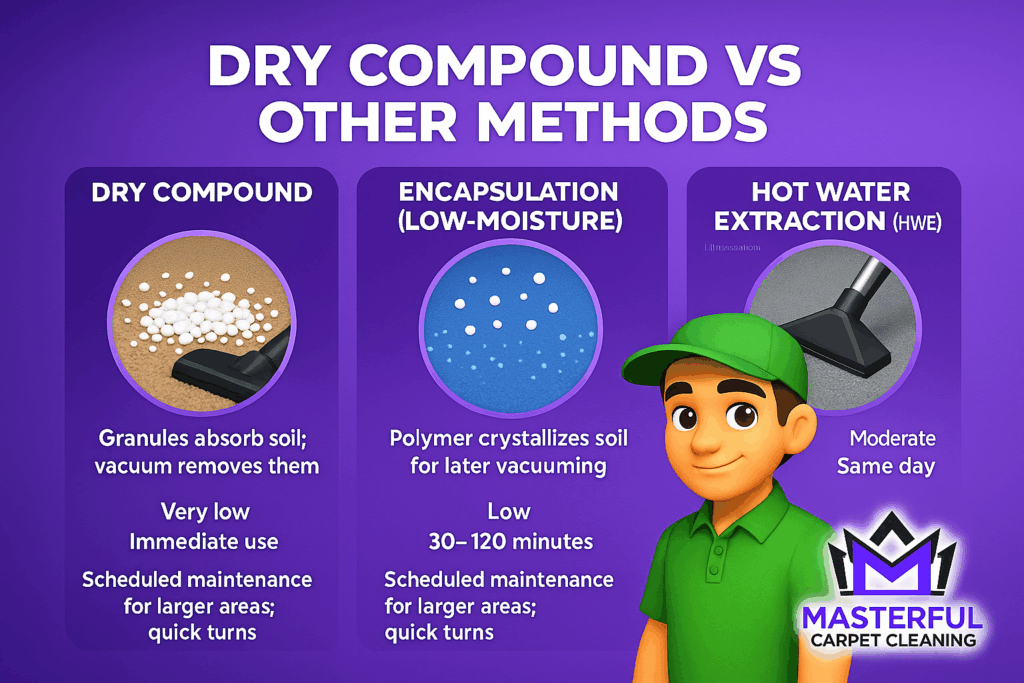
Dry compound vs encapsulation vs hot water extraction
| Method | How it removes soil | Moisture use | Typical dry time | Best fit |
|---|---|---|---|---|
| Dry compound | Granules absorb soil; vacuum removes them | Very low | Immediate use | Moisture sensitive fibers/backings; tidy interim work; localized areas |
| Encapsulation (low-moisture) | Polymer crystallizes soil for later vacuuming | Low | 30-120 minutes | Scheduled maintenance for larger areas; quick turns |
| Hot Water Extraction (HWE) | Rinse with heated water; high lift vacuums recover soil & residues | Moderate | Same day | Restorative resets; sticky residues; urine/odor work |
Our visit workflow (start → finish)
- Pre-inspection & fiber ID – We confirm fiber type, construction, any dye or moisture sensitivity, and note traffic patterns.
- Dry soil removal – A thorough pre-vacuum removes loose grit first, key for a clean finish with any method.
- Compound selection – We choose the right grade based on fiber and soil type. Some areas might need a denser or lighter compound.
- Application & agitation – We apply compound evenly and gently brush it in. The goal is contact, not grinding.
- Dwell time – A short, controlled dwell allows soil transfer to the granules.
- Recovery – High quality vacuuming lifts the soiled granules out. We run detail passes along edges, under furniture lips, and near transitions.
- Spot retouch – Any stubborn marks get a targeted re-application and re-vacuum.
- Final walk through – We check the results together and cover simple aftercare.
Why our results hold: correct compound choice + proper recovery. When a deeper reset is needed, we’ll do that first (see Best Carpet Cleaning for High Traffic Areas), then use low-moisture strategies to maintain the look without disruption.
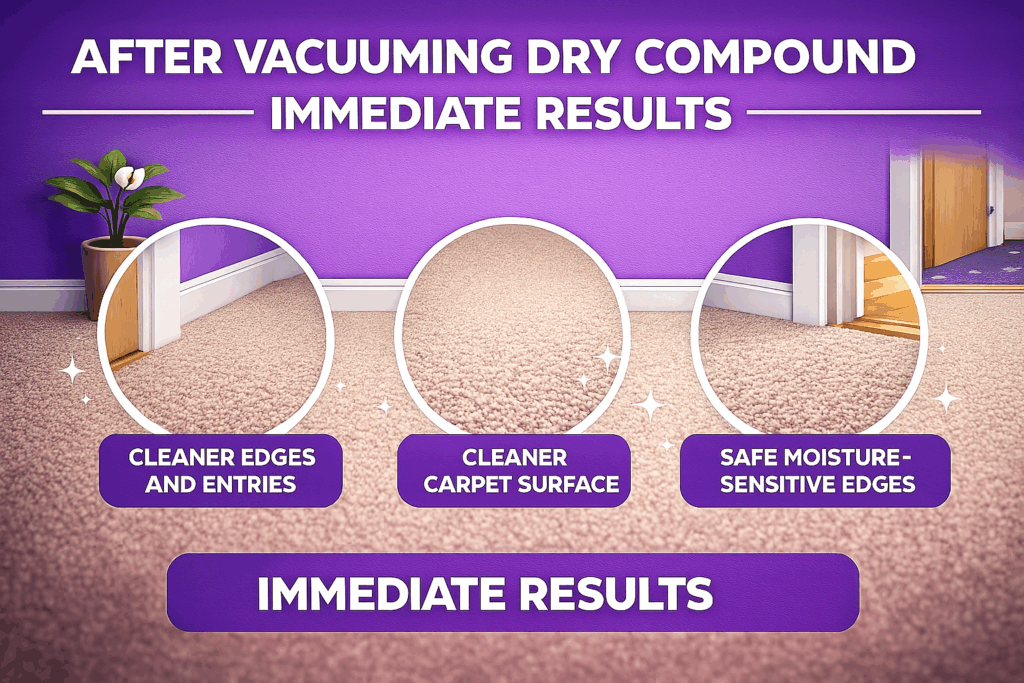
Results you can expect (Oregon reality check)
- Immediate use after service, no wet carpet signs.
- Visible brightening of light, moderate soil and common traffic marks.
- No moisture related risks for sensitive fibers/backings when performed correctly.
- Cleaner edges and entries where fine soil likes to gather.
Limitations to set expectations: dry compound is interim by design; it won’t fully reverse crushed wear patterns, deep oily soil, or subsurface urine. When a true reset is required, we’ll outline a restorative HWE and then schedule low-moisture maintenance (compound/encap) to hold your results, this is standard in building care; see Commercial Carpet Cleaning for cadence examples.
FAQs
Will dry compound scratch my carpet? No. Modern compounds are made to be gentle. We use controlled agitation and strong vacuum recovery.
How fast can I walk on it? Right away, that’s a key advantage vs wet methods.
Does dry compound remove pet urine smells? It can reduce surface odor, but deeper contamination in backing/pad needs targeted decontamination + extraction. Learn what that includes here: Pet Odor Elimination.
Is it safe for wool? Yes, with gentle agitation and careful vacuuming. For dyed wools or delicate weaves, we may blend techniques to protect the piece.
Will granules be left behind? Good technique = thorough pickup. We run detail passes so you’re not finding granules days later.
Is it eco-friendly? Many compounds are low-moisture and low-VOC. If you have sensitivities, tell us, we’ll select accordingly and improve ventilation. For allergy minded households, this context helps: Carpets, Indoor Air Quality & Allergies.
How should I prepare? Clear small items, reserve parking close to the entry, and point out spots/spills during the walk-through. Handy one pager: Appointment Checklist.
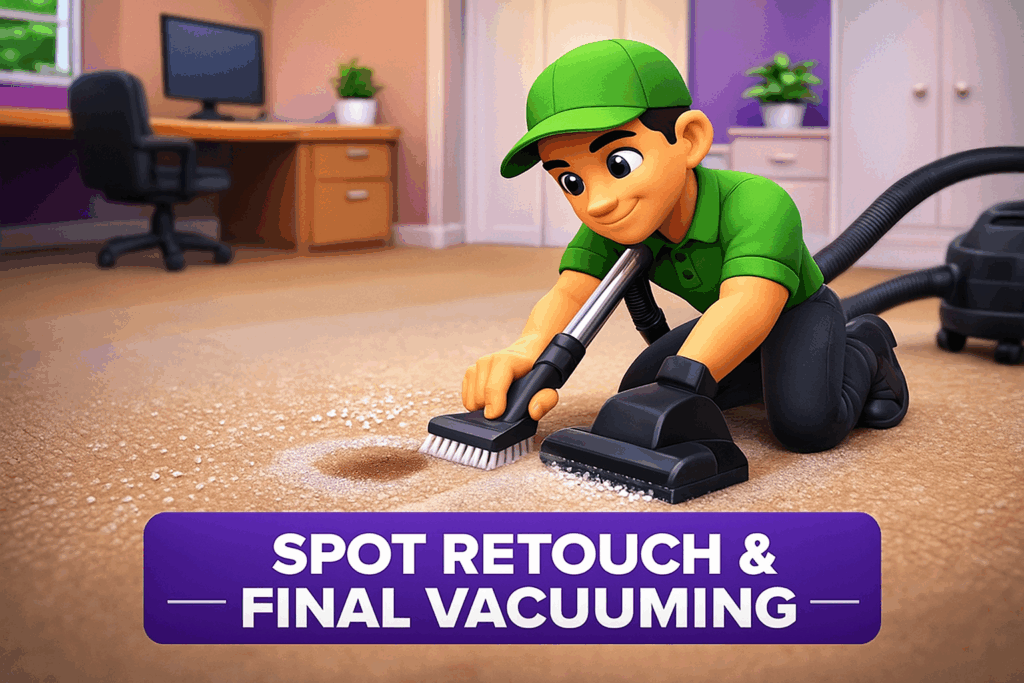
Prep & aftercare (simple checklist)
Before we arrive
- Pick up small items; move breakables (we’ll advise on heavy pieces).
- Reserve a parking spot near the entry and clear a path for equipment.
- Pre-vacuum if you can, helpful, not required.
- Point out spots, pet areas, or sensitive rugs during the walk-through.
Aftercare
- Vacuum high use areas within 24-48 hours to capture any last trace of compound (especially if we retouched stubborn spots).
- Keep a routine vacuum schedule, it’s the #1 maintenance tool.
- Use spotters sparingly; over-application can create residue. For moisture/drying topics in other contexts, see Properly Drying Carpet: Preventing Mold & Mildew.
Choosing the right path (quick decision aid)
- Pick dry compound if you need immediate use, have moisture sensitive carpets, or want tidy interim maintenance without downtime.
- Pick encapsulation when you want fast, scheduled maintenance across larger areas with predictable turnaround: How Encapsulation Carpet Cleaning Works and Encapsulation: Benefits & Techniques explain the what/why.
- Pick hot water extraction (HWE) when your goal is a restorative reset, you’re fighting sticky residues, or you need to tackle urine/odor at the source. For why finishing matters in HWE, see No Residue Carpet Cleaning.
Local service promise (Greater Oregon)
We design every visit around your schedule and your surfaces. In wetter months, we plan airflow and recovery carefully so homes and businesses in Salem, Corvallis, Eugene, McMinnville, and Albany get exactly what they need: clean carpets with minimal disruption. For high traffic corridors or facilities that can’t go offline, we’ll map a maintenance cadence that alternates restorative HWE with low-moisture cycles (dry compound/encap) so results last and budgets stay predictable; see Commercial Carpet Cleaning for how we schedule it.
Final note on expectations
Dry compound is a fantastic tool when speed, tidiness, and low moisture matter most. It keeps sensitive pieces safe and buys you time between deep cleans. When the carpet needs a true reset, we’ll tell you honestly, and then pair that reset with a maintenance cadence so you don’t need it as often. If you’re unsure which path fits your home or facility, a quick walk through is usually all it takes to recommend the right mix.
As the Co-Owner of Masterful, Randy has been providing quality cleaning services to the Salem and Portland areas of Oregon for many years. He has built a reputation for excellence in the industry. His team take prides in using the latest cleaning techniques and technologies to deliver exceptional results every time. Author

